07 Mar, 2024
Game Genres
How to classify games?
- Games can be classified using their descriptive features:
- Dimensions of the world
- Perspective / Camera
- Actions
- Challenges
- Player Count
- Story
- and others
How to classify games?
- We can categorize games into two main classes:
- Action
- faster,
- based on reflexes,
- requires physical skills,
- Strategy
- slower (usually)
- based on logic and thinking
- requires mental skills
- Action
- Note that these are not strict definitions, as we will see
Action Category
- Action games provide simpler, instantenous actions to the player
- Movement actions: Move in main dimensions of the world, may also include special movement such as jump, fly, etc.
- Fighting actions: Fighting actions allow the player to hit other players and NPCs. May include melee, ranged and magical hitting actions.
- Interactions: Allows the player to interact with the game world in a simple manner, such as openning a door or chest, pushing a crate, or digging a hole.
Strategy Category
- Strategy games provide more complex, delayed actions to the player
- Building actions: Allow the player to build, construct or develop an in game object, such as a building, a resource mine, or an axe
- Management actions: Allow the player to convey management directives to the game world, such as hiring a staff, increasing production, decreasing taxes, or determining tactics in a football game
- Explore/Espionage actions: Allow the player to gather information about the game world initially unknown to the player.
Action Category
- Action games throw more physical challenges to the player:
- Time challenge: time challenges require the player to finish the level in a given amount of time
- Dexterity challenge: dexterity challenges require the player to act agile and with more eye-brain coordination, usually in quick bursts
- Endurance challenge: endurance challenges require the player to consistently keep a high level of concentration for long time periods
Strategy Category
- Strategy games throw more mental challenges to the player:
- Memory challenge: memory challenges require the player to use knowledge learned prior to or during game play time
- Logic challenge: logic challenges require the player to solve logical puzzles, and develop algorithms and procedures for solving problems
- Management challenges: management challenges require the player to control a limited amount of resources to produce a maximal amount of outcome
Actions vs Challenges
- A game’s design is based on action-challenge balance.
- A good game provides many challenges that can be solved with a small set of actions through multiple emerging strategies
- A bad game provides few challenges that can be solved with a large set of actions through a single linear strategy
Examples
- Mario
- Actions
- move left, move right, jump
- Challenges
- collect coins, avoid enemies, kill enemies, avoid falling down, navigate platforms, find treasure rooms, find hidden passages, find boosters, jump to the flag for high score, finish level
- these challenges can mostly be done with quite different approaches
- Actions
Examples
- Diablo
- Actions
- move in 2D, melee attack, cast magic, interact with chests and objects, use potions, use skills
- Challenges
- Kill enemies, find loot, avoid being killed, navigate world, find passages, solve puzzles/labyrinths, collect item sets, find unique items, kill bosses, upgrade items, upgrade avatar, optimize build
- main challenges are mostly linear, side challenges are very variable
- Actions
Game Genres
- A genre is a defining sub-category with observations having similar features
- It is usually difficult to assign a single genre to modern games
- Older games used to stick to one genre due to limitations
- The main genres in gaming are:
- Action
- Adventure
- Role Playing
- Simulation
- Strategy
- Sports
- Puzzle
Action Games
Action Games

- Action games are games that absorb the player into game play by requiring quick reflexes and total concentration to win.
- Many subgenres are associated with action games, including the following:
- Arcade
- Scroller / Platform
- First Person Shooter (FPS)
- Third Person Shooter (TPS)
- Fighting
- Stealth
- Survival
- Arcade classics like Breakout (1976) and Asteroids (1979) are pure examples of action games. In his 1982 book The Art of Computer Game Design, industry pioneer Chris Crawford categorises all arcade titles as skill-and-action games.
Action Games
- Action games are one of the most popular video game genres in the world
- Typically feature physical challenges that are overcome by jumping, fighting, and shooting
- Excellent hand-eye coordination and twitch reflexes are typically required
- The action normally revolves around the user’s character who must pass the series of challenges in order to progress to the next level
Platform Games

These games, like Mario, have the player take control of a character, usually in the third person. They have to usually jump and navigate around a level akin to an obstacle course.
Famous examples of platforming games:
- Trine
- Mario
- The Prince of Persia
Shooter Games

- The player’s primary goal is to defeat the character’s opponents with the weapons available to him.
- Usually rifles or other long-range weapons
- Grenades for indirect offensive,
- Armor for additional defense,
- Telescopic sights to alter the weapons’ behavior, etc.
- Shooter Games have the following subgenres:
- 3D Shooters
- FPS
- TPS
- 2D Shooters
- Top down shooters
- Side-scrollers
- 3D Shooters
FPS

The cream of the crop, and some of the most popular games in recent memory, FPS titles have sold millions upon millions of copies and engage players of all ages in the fast-paced action.
Call of Duty is the prime example, having addictive multiplayer gameplay, as well as exhilarating single-player stories.
Noteworthy examples:
- Counter-Strike: Global Offensive
- Wolfenstein 3D
- Left 4 Dead 2
- Doom
- Paladins
- Overwatch
TPS

- Third-person shooter (TPS) is a subgenre of 3D shooter games in which the gameplay consists primarily of shooting.
- It is closely related to first-person shooters, but with the player character visible on-screen during play.
- the TPS genre is distinguished by having the game presented with the player’s avatar as a primary focus of the camera’s view.
Noteworthy examples:
- Fortnite
- Hitman
- Mafia
Top down shooters

- The avatar and the game world is seen from the top
- Seperates into two:
- Top down scrollers (aka. shoot’em ups)
- The avatar constantly moves up the screen
- Enemies appear from the top of the screen and descend upon the avatar
- Top down shooter (aka. bullet hell)
- Enemies approach from everywhere
- The avatar moves around the world freely
- Top down scrollers (aka. shoot’em ups)
- Galaga, Crimson Land
Side scrollers

- A side-scrolling video game (alternatively side-scroller) is a game viewed from a side-view camera angle where the screen follows the player as they move left or right.
- The jump from single-screen or flip-screen graphics to scrolling graphics during the golden age of arcade games was a pivotal leap in game design, comparable to the move to 3D graphics during the fifth generation.
Noteworthy examples:
- Defender
- Gradius
Fighting

- Fighting is a game genre in which two (or more) players fight each other.
- Blocking, grappling, counter-attacking, and chaining attacks together into combos
- Hand-to-hand combat is used by the characters in most battles
- Fighting game genre is linked to but separate from the beat ’em up genre
- one or more player characters against a huge number of computer-controlled enemies
Noteworthy examples:
- 2D: Street Fighter
- 3D: Super Smash Bros, Tekken, Soul Calibur
- Beat ’em Up: Golden Axe, Little Fighter II, Castle Crashers, Double Dragon
Beat ’em Up
Stealth Action

In contrast to most action games, stealth action games require the player to avoid alerting attackers at all costs. The current stealth game’s basic gameplay elements are to avoid battle, make as little noise as possible, and strike foes from the shadows and behind. Completing goals without being discovered by enemies, sometimes known as “ghosting,” is a popular strategy in stealth games. While avoiding detection may be the sole way to complete a game, there are usually several paths or styles of play that can be used to accomplish a goal.
Noteworthy examples:
- 2D: Deadbolt, Gunpoint, Inside
- 3D: Metal Gear Solid, Thief
Survival

Survival games are considered an extension of a common video game theme in which the player character is stranded or separated from others and must work alone to survive and complete a goal. The player generally starts out with a minimal amount of equipment and must attempt to remain alive as long as possible by crafting tools, weapons, shelters, and collecting resources.
Noteworthy examples:
- 2D: Terraria, Starbound, Stardew Valley, Don’t Starve
- 3D: Rust, Ark, SCUM, Subnautica, The Long Dark, The Forest
Action-Adventure


This is a hybrid genre that contains elements from both action and adventure genres. Although most gameplay is built around action mechanics, there is a strong story element that unfolds as you play.
We can consider survival-horror and metroidvania as a sub genre of this genre.
Survival-Horror

Survival horror refers to a subgenre of action-adventure video games that include horror game elements. The character of the player is vulnerable and under-armed, putting the emphasis on puzzle-solving and escape, rather than the player taking an offensive strategy. The games usually challenge the player to manage his inventory and ration scarce resources such as ammo. A survival horror story generally involves investigating and confronting horrible forces, and therefore many games turn common elements of horror fiction into gameplay challenges.
Metroidvania
/cdn.vox-cdn.com/uploads/chorus_asset/file/25248273/Metroid_Prime_4.jpg)
The player can explore a wide interconnected world map in Metroidvania games, while entry to certain areas is typically restricted by doors or other obstacles that can only be overcome if the player has obtained unique objects, equipment, weapons, powers, or information within the game. Maps are non-linear, and players are usually required to travel the map many times throughout the game. Larger games generally include save spots and even the ability to transfer the player rapidly between specific rooms on different sides of the map, it minimizes needless backtracking in the game stages.
- 2D: Hollow Knight, Dust: An Elysian Tail, Metroid: Samus Returns, Ori and the Blind Forest
- 3D: Metroid Prime
Adventure
Adventure Games
- Adventure games are single-player games with a compelling story.
- More than any other video game genre these games depend heavily on their plot and scenario to provide an engaging single-player experience.
- Puzzles, decoding messages, locating and using tools, opening locked doors, and discovering and exploring new places are all part of adventure games.
- An inventory management interface is a distinct gameplay style in many adventure games.
- Because players can only pick up certain objects in the game, they usually understand that only those objects that can be picked up are essential.
Adventure Games
- Adventure genre usually blends into other genres. However, there are some very distinct sub-genres:
- Text adventures
- Point and Click adventures
- Visual novels
Text Adventures

Text adventures (also known as interactive fiction) are text-based games in which worlds are described in the narrative and the player interacts with the worlds using typically basic commands. This game genre usually blends with the roleplaying genre.
The game would often prompt the player with an open-ended what do you do? after describing the environment they are in. If the player wakes up in a cave, the player could type in turn left, light torch, and walk forward to advance the game.
Point and Click
Point-and-click adventure games are those where the player typically controls their character through a point and click interface using a computer mouse or similar pointing device, though additional control schemes may also be available.
The player clicks to move their character around, interact with non-player characters, often initiating conversation trees with them, examine objects in the game’s settings or with their character’s item inventory.
These games come down to collecting items for the character’s inventory, and figuring when is the right time to use that item.
- King’s Quest, Larry, Indiana Jones, Monkey Island
Visual Novels

Visual novels differ from other game genres in that they have far less gameplay. The majority of player input is mainly limited to clicking to keep the text, images, and sound going while making narrative decisions.
Another distinguishing feature of visual novels is their great emphasis on writing, as the narrative is provided through text. Playing visual novels is extremely similar to reading a book because of this feature.
Most visual novels have several storylines and endings; the mechanic in these games is usually a series of multiple-choice decision points when the player chooses which path to take the game in.
Examples: Zero Escape, The Death Trap, Ace Attorney, EVE
Role Playing Games
Role Playing


RPGs are games in which the player takes on a ‘role’ of a character in a (usually), fantastical setting, allowing the player to out the roles. These are made famous from tabletop gaming like Dungeons & Dragons, in which players would take their created character and journey through dungeons and towns, using skills to tailor their journey In unique ways.
The player is required to overcome difficult challenges and/or defeat monsters, to gain experience points which represent the character’s progress in a chosen profession or class and allow the player to gain new abilities once a set amount is obtained.
Role Playing Subgenres
There are many subgenres of the RPG genre:
- Action RPG
- MMORPG
- Roguelikes
- Tactical RPG
- Sandbox RPG
- First-person Party-based
- JRPG
Action RPG
An action role-playing game (often abbreviated action RPG or ARPG) is a combination of core elements from both action games and role playing genres. Contrary to turn or menu-based combat, action RPGs emphasize real-time combat where the player has direct control over the characters.
Diablo 2, The Witcher 3: Wild Hunt, Nier: Automata, The Witcher 3: Cyberpunk 2077, Sands of Salzaar, Wasteland 3, Wild Hunt, Assassin’s Creed Origin, Assassin’s Creed Odyssey, Grand Theft Auto
MMORPG
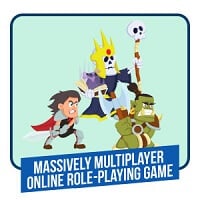
A massively multiplayer online role-playing game (MMORPG) is a type of role-playing video game in which a huge number of people interact in a virtual world. MMORPGs differ from single-player or small multiplayer online RPGs in the amount of players who can interact with each other, as well as the game’s persistent universe (typically hosted by the publisher), which continues to exist and expand even when the user is offline and away from the game.
Path of Exile, World of Warcraft, Final Fantasy XI, The Lord of the Rings Online: Shadows of Angmar, and The Elder Scrolls Online, Guild Wars 2
Roguelikes
The name and gameplay aspects of the roguelike video game subgenre come from the 1980 computer game Rogue. A roguelike (or rogue-like) is a type of role-playing video game that features
- dungeon crawl through randomly generated levels,
- turn-based gameplay,
- grid-based mobility,
- and permadeath (no save)
The majority of roguelikes have a high fantasy storyline, owing to their inspiration from tabletop role playing games like Dungeons & Dragons.
Examples: NetHack, ADOM, Angband
Roguelikes vs Roguelites
- There is (was) a hype to tag any and everygame as a roguelike around 2020s.
- 90% of games tagged as roguelike in Steam has nothing to do with being roguelike
- Hence, a new term was invented: roguelite
- That is, not a rogue-like, but borrows elements from roguelikes
- Many popular games branded as roguelike are actually roguelite
- Hades
- Dead Cells
- Enter the Gungeon
Tactical RPG
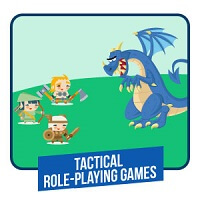
Tactical role-playing games are a subgenre of role-playing video games that integrate aspects from both role-playing and tactical (turn-based or real-time) strategy games. It’s also known as strategy role-playing games and simulation role-playing games in Japan (both abbreviated SRPGs). As an alternative to standard role-playing game (RPG) systems, they primarily refer to games that incorporate features from strategy video games. The genre has its roots in tabletop role-playing games, in which each player has the freedom to choose the actions of his or her characters.
Examples: Mordheim, Final Fantasy Tactics, Suikoden Tactics, Vanguard Bandits and Disgaea, Arc the Lad II, Arc the Lad III, Arc the Lad: Twilight of the Spirits
Sandbox RPg
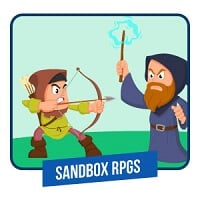
Sandbox RPGs, often known as open world RPGs, provide the player a lot of flexibility and usually feature a world that is more open and free-roaming (meaning the player isn’t bound to a particular path by rocks, fences, or other obstacles). Sandbox RPGs are similar to other sandbox games, such as the Grand Theft Auto series, in that they have a large number of interactable non-player characters, a large amount of content, and typically some of the largest worlds to explore and the longest playtimes of any RPG due to an impressive amount of secondary content not critical to the main storyline.
Examples: Kynseed, Zelda II, Wasteland, System Shock 2, Deus Ex, The Elder Scrolls and Fallout series…
First-person Party Based
First-person party-based RPGs are also known as DRPG (Dungeon RPG). In this type of RPGs, the player guides a group of adventurers through a dungeon or labyrinth in first-person perspective, usually in a grid-based setting. Because the player moves the entire party across the playing field as a single entity, or “blob,” they are also known as “blobbers.” The majority of “blobbers” are turn-based, but other series like Dungeon Master, Legend of Grimrock, and Eye of the Beholder are real-time.
Examples: Wizardry, Might and Magic and Bard’s Tale series, Etrian Odyssey, Elminage series
Third-Person Party Based
Similar to FPPB games, but this time you see the world from third-person perspective and can control and command party members more fluently. The setting of the scene becomes important. Player usually gets a chance to rearrange positions of the characters before a fight. This genre is usually a synonym for TRPGs.
Example: Dungeons of Nahelbeuk, Baldur’s Gate, Icewind Dale
JRPG
JRPGs (Japanese Role-Playing Games) are a type of role-playing game that differs from those played in the West. JRPGs are frequently made by Japanese developers, but this is not always the case. The term “JRPG” comes from the term “console RPG,” which refers to games like Dragon Quest and Final Fantasy. Because the term JRPG now refers to a wide spectrum of RPGs, it is no longer considered a genre, but rather an umbrella term. Japanese role-playing games have a more linear plot and a predetermined cast of characters. They typically have a large number of adversary encounters and may require grinding in order to progress further in the game.
JRPG Games: Pokemon, Final Fantasy Series, Chrono Series, Tales Series…
Simulation Games
Simulation Games
A simulation game attempts to copy various activities from real life in the form of a game for various purposes such as training, analysis, prediction, or entertainment. Usually there are no strictly defined goals in the game, and the player is allowed to control a character or environment freely. Well-known examples are sports simulation, war simulation, business simulation, and role play simulation.
Subgenres are
- city building
- construction
- management
- life simulation
- vehicle simulation
City Building

City-building has the player construct cities from the ground up. Cities: Skylines and SimCity are great examples of this genre.
Not only does the player build buildings, but they partake in connecting powerline, water mains, highways, and byways.
Construction
Construction simulations are usually single-player games since competition would force players to sacrifice originality in favor of efficiency and a scramble for resources. They usually offer a free-form construction mode where players can create whatever they like, appealing to a player’s feeling of creativity and need for control. As a result, many CSs have no win condition, despite the fact that players can always lose by running out of resources. The player must correctly manage their economy in order to develop larger inventions and earn more creative power in these games.
Examples: World of Goo, Construction Simulator Pro, SimCity BuildIt, …
Management
Management games put the player in the boots of a manager, responsible for the management of a company, team or organization. Most famous examples are sports management games, but corporate management, dungeon management, tavern management etc. are also popular themes.
The player usually plays with a huge number of input parameters to optimize a certain set of outputs. For example, in a football simulation, the purpose is to build the best squad by training and transferring players, keeping good relations with members of the team and the fans, etc.
Examples: Championship Manager, FM2024, Graveyard Keeper, Tavern Manager Simulator, Capitalism
Life Simulation

Players are given the ability to influence the lives of autonomous individuals or creatures in life simulation games, which are about “maintaining and expanding a virtual life.” Artificial life games are linked to artificial life research in computer science. God games, which concentrate on controlling tribal worshipers, as well as artificial pets, which focus on one or more animals, fall under this wide category. It also contains genetic artificial life games, in which players manage animal populations across multiple generations.
3D Examples: The Sims, Shelter 2, Eco, Seventh Cross: Evolution
2D Examples: Alter Ego, Jones in the Fast Lane, Little Computer People, E.V.O.: Search for Eden
Vehicle Simulation

Players can drive or fly a vehicle in vehicle simulation games. This vehicle could be based on a real vehicle or a creation of the game designer. Vehicles in the air, on the ground, across the water, and even in space fall under this category. Vehicle simulations can include a range of objectives, such as racing, warfare, or simply getting the feel of operating a vehicle. In most cases, these games allow the player to see the action through the eyes of the pilot or driver. A wide range of vehicles is included in this category, including aircraft, spaceships, boats, cars, trucks, motorcycles, and so on.
Examples: F1 2021, Dirt Rally 2.0, Forza Motorsport 7, Flight Simulator 2020, Euro Truck Simulator 2, City Bus Simulator
Strategy Games
Strategy Games
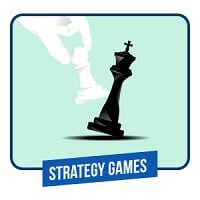

Strategy is a popular video game genre that emphasize thinking and planning over direct instant action in order to win. A player must execute a series of activities against one or more opponents, with the purpose of reducing opposing troops. Victory is accomplished through greater planning, with luck playing a minor role.
In most strategy video games, the user is granted a godlike view of the game universe and indirectly commands the game units. As a result, most strategy games include tactical and strategic factors, as well as elements of warfare to varying degrees. These games frequently test the player’s ability to explore and manage an economy, in addition to fighting.
Strategy Subgenres
Strategy genre has many sub genres, mostly borrowing elements from other genres:
- 4X
- Artillery
- Auto-battler
- Real Time Strategy
- Real Time Tactics
- Multiplayer Online Battle Arena
- Tower Defense
- Turn-based Strategy
- Turn-based Tactics
4X
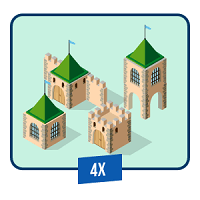

Traditionally, the 4X game genre is defined by having the following four gameplay conventions:
- eXplore - Players send scouts over a map to reveal nearby territory
- eXpand - Players claim newer territory by establishing new settlements or increasing the power of existing ones.
- eXploit – Players collect and use resources in areas they control, with the goal of increasing the efficiency of that use.
- eXterminate – it refers to the act of attacking and eliminating other players. Because all territory in some games is eventually seized, eliminating a rival’s presence may be the only way to expand further.
4X

In 4X games, - Research is crucial since technological advancement is a source of conquest - Superior military technology or higher numbers are frequently used to win battles - Battle tactics have a lower role - A technology tree is common - Empires must invest in new technology and produce research resources
- The majority of 4X and equivalent strategy games include several methods to win
- Multiple victory conditions aid the human player, who may need to change plans as the game continues and opponents obtain vital resources before he or she does.
Examples: Civilization, Age of Wonders, Stellaris, Warhammer 40000
Artillery

Artillery games are two- or three-player (typically turn-based) video games that include tanks (or simply cannons) attempting to destroy one another. Most often, the primary elements of the game are to aim at the opponent(s) on a ballistic trajectory (in its simplest form, a parabolic curve). Before firing, the player is usually expected to input an angle and velocity, and games frequently ask the player to adjust for wind and other conditions. Although the game might be classified as a shooter because players fire projectiles at one another, it mainly resembles a strategy video game.
Examples: Scorched Earth, Worms, Hogs of War 2, Hedgewars
Auto Battler
![]()
An auto battler, often known as auto chess, is a type of strategy video game that typically include chess-like components in which players deploy characters on a grid-shaped battlefield, who automatically fight with the opposing team’s characters without the player’s control.
Similar to a battle royale, auto battler games often involve multiple players competing against each other as individuals. Each player deploys a team of troops, known as minions, with the goal of forming the most powerful team possible.
Examples: Teamfight Tactics, Hearthstone Battlegrounds, Dota Underlords
Real Time Strategy
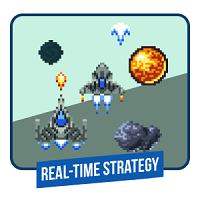
Real-time strategy (RTS) is a subgenre of strategy video games in which all players play at the same period, in “real-time.
Objectives:
- Build and expand base
- Collect resources
- Train units
- Destroy enemies
So it is practically 4X in real time.
Examples: Dune, Starcraft, Command and Conquer, Warcraft
Real Time Tactics
Real-time tactics (RTT) is a subgenre of tactical wargames that are played in real-time to simulate operational warfare and military tactics. It differs from real-time strategy games in that it lacks traditional resource management and base or unit construction, as well as a higher emphasis on individual units and complicated combat tactics. Real-time strategy games urge players to focus on logistics and production as much as or more than fighting, whereas real-time tactics games focus on tactical and operational aspects of warfare such as unit formations and terrain exploitation for tactical advantage.
Examples: Total War: Warhammer, Shadow Tactics: Blades of the Shogun
Multiplayer Online Battle Arena
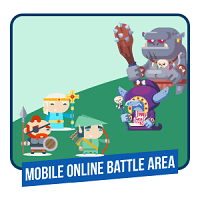
MOBA is a type of strategic video games in which two teams of players combat against each other on a predefined battleground. Each player controls a single character with a unique set of skills and contribute to the team’s overall strategy. Each team’s ultimate goal is to destroy their opponent’s main structure. In some MOBA games, the goal is to defeat the opponent team’s whole squad.
MOBAs are a sort of multiplayer online video game that began as a subgenre of real-time strategy, however, players rarely develop buildings or troops.
Examples: League of Legends, Smite, Heroes of the Storm, Defense of the Ancients, Arena of Valor, Heroes of Newerth, Vainglory
Tower Defense
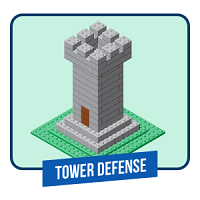
Tower defense (TD) is a strategy game subgenre in which the goal is to defend a player’s territories or belongings by blocking opposing attackers or preventing enemies from accessing exits, usually by building defensive structures on or along their attack path.
The following are the basic gameplay features of tower defense:
- The Base that the player or players must defend.
- Multiple waves of oncoming “enemy” must be defended against.
- Tower features, such as towers or barriers, are placed in the way of attacking opponents.
Examples: Plants vs Zombies, Diamond Rush, Dungeon Warfare 2, Dungeon Defenders II, Zombie Builder Defense
Turn Based Strategy
Turn-Based Strategy Games are a type of military simulator or a subgenre of strategy games that are often entirely abstract. The players take control of a number of pieces or units and take turns managing them on a rectangle or hexagonal grid. Each turn, players typically move a unit, assault an opponent unit, or exploit natural resources, most commonly by recruiting additional units or constructing more fixed facilities. Each unit can typically move and then perform one more action per round. Play usually ends when a certain goal is met, such as the destruction of all enemy units (or structures), though timed games are also popular. The most classic ancestor of this genre is chess.
Examples: War Tales, XCom 2, Turmoil
Turn Based Tactics
Turn-based tactics (TBT), also known as tactical turn-based (TTB), is a computer and video game genre of strategy video games that simulate the considerations and circumstances of operational warfare and military tactics in small-scale confrontations rather than the more strategic considerations of turn-based strategy (TBS) games through stop-action simulations.
Because of the tactical consequences of elevation, hard cover, and line of sight, turn-based tactics games frequently offer more detailed and complex settings than other strategy games.
Examples: Phantom Doctrine, Legions at War, Blood Bowl 2, Star Wars Tactics, Hired Guns: The Jagged Edge
Sports Games
Sports Games


A video game that simulates the practice of sports is known as a sports video game. Most sports, including team sports, track and field, extreme sports, and combat sports, have been replicated with a game. Physical and tactical challenges are present in sports games, which put the player’s precision and accuracy to the test. Most sports games seek to simulate athletic aspects such as speed, strength, acceleration, precision, and so on. These games, like their respective sports, are held in a stadium or arena with clearly defined borders. Recorded audio is frequently used in sports games to give play-by-play and color commentary.
Sports Game Genres
Sports game subgenres are mostly based on the way the actual sport is being executed:
- Team Sports
- Individual Sports
- Fighting Sports
- Racing
Team Sports

Team sports games are one of the oldest forms of video game genres. They simulate playing a sport ranging from football to soccer to rugby to baseball. Some games, such as Arch Rivals and NBA Jam, poke fun at the genre, while others, such as Madden NFL and FIFA, attempt to emulate the authenticity and feel of playing a live game.
Examples: Striker, FC24, NBA24
Individual Sports
Individual Sports Games include solo sports such as skateboarding and snowboarding and the games within this video game genre typically try to simulate reality as much as possible.
Examples: Shredders Snowboard Sim, Tony Hawk’s Pro Skater 1 + 2, Shaun White Snowboarding: Road Trip, SSX
Fighting Sports

Sports-based fighting games, such as boxing and wrestling games, are titles that fit well into both the fighting game and sports game genres. As a result, they’re frequently divided into subgenres of their own. Many incorporate real-world franchises or fighters, and the fighting is often significantly more realistic than in standard fighting games (though the degree of realism varies).
Examples: Fight Night, UFC 2009 Undisputed, EA Sports UFC, WWE
Racing
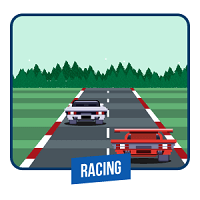
Racing video games are video games in which players control a vehicle that competes against other vehicles on a series of racetrack or levels, with the objective of reaching the finish line first. Some racing video games, such as Sonic R, do not require the use of automobiles; some games only depict characters running.
There are numerous racing sub-genres, all of which are distinct from one another. While they all have the similar goal of racing to the end of the track before everyone else, each sub-genre has its own gameplay and focus.
Examples: Forza Horizon 5, Forza Motorsport 7, Need for Speed, NASCAR Heat 3, F1 2021
Racing Subgenres

Arcade racing games: Arcade-style racing games prioritise enjoyment and a fast-paced experience, as automobiles race in a variety of ways. Arcade-style races have significantly more liberal physics than simulation racers, which is a crucial aspect that distinguishes them from simulation racers. Whereas in real racing (and its simulation versions), the driver must slow down significantly to take most turns, arcade-style racing games urge the player to “powerslide” the car into a turn, allowing the player to maintain their pace. Collisions with other racers, track barriers, or traffic vehicles are frequently overdone in comparison to simulation racers.
Racing Subgenres

Futuristic racing games: Futuristic racing games are a form of racing game in which players race against the clock or other vehicles in science fiction vehicles such as sci-fi cars or other sci-fi vehicles. Vehicle combat may be included in a number of futuristic racing games.
Racing Subgenres

Kart racing games: Kart racing games offer simplified driving principles while incorporating hazards, unique track designs, and a variety of action components. Kart racers are also known for casting characters as “wacky” vehicle drivers who have appeared in many platform games or cartoon television series. Kart racing games are more arcade-like than other racing games, and they frequently include rounds where player characters can launch projectiles at each other or earn power-ups. Typically, vehicles in such games move more like go-karts, with no gear lever or clutch pedal.
Racing Subgenres

Simulation racing games: The goal of simulation racing games is to accurately simulate the physics and handling of a car. If they can’t get an official license for genuine vehicles or racing leagues, they’ll use fantasy cars that look like real ones. The physics of vehicular behavior are crucial to the experience. Professional race driver rigours (such as dealing with a car’s tyre condition and fuel level) are frequently incorporated as well. Simulated racing games prioritize proper turning skill and precision racing moves (such as trail braking).
Puzzle Games
Puzzle Games

Puzzle games put the player’s problem-solving skills to the test, requiring them to recognize patterns, solve sequences, and complete words. Main types are
- crossword puzzles
- word-search puzzles
- number puzzles
- relational puzzles
- logic puzzles
While many action and adventure games incorporate puzzle aspects into their level design, a real puzzle game prioritizes problem solving as the primary gameplay activity.
Puzzle Subgenres
There are two main puzzle game subgenres:
- Trivia games
- Logic games
Trivia Games

These games involve players in answering general or specific trivia questions to score points and win.
Trivial Pursuit, HQ, and Trivia Crack are all great trivia games that are extremely popular.
Here are more examples:
- QuizUp
- Jeopardy! World Tour
- Trivia 360
- Family Feud
- SongPop
Logic Games

The Logic video game genre requires solving logic puzzles or navigating difficult environments such as mazes in order to pass levels and score points. Tile-matching puzzle games are among the most popular casual games because they are perfectly suited to informal play. Adventure and instructive games regularly cross into this category. Tetris, a puzzle game, is credited with altering gaming and bringing the puzzle genre to a wider audience.
Examples: Cut the Rope, Candy Crush Saga, TIM